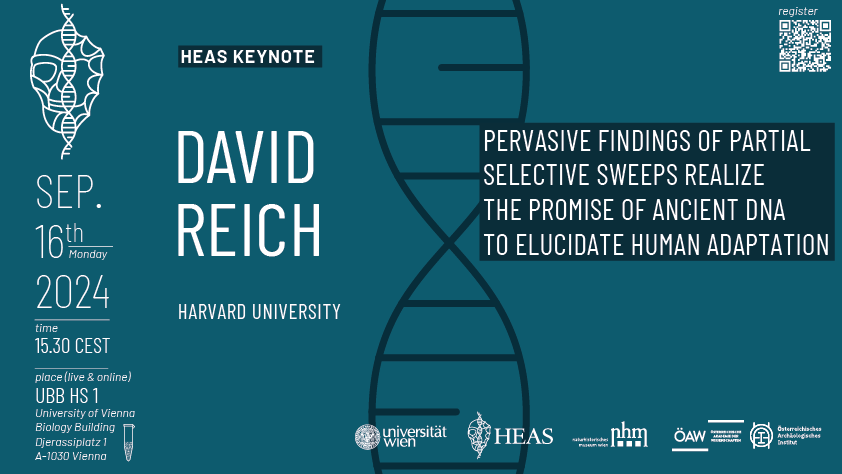
- Diese Veranstaltung hat bereits stattgefunden.
HEAS Keynote with David Reich
16. September 2024 @ 15:30 - 17:00

Pervasive findings of partial selective sweeps realize the promise of ancient DNA to elucidate human adaptation.
David Reich is a Professor of Genetics and Human Evolutionary Biology at Harvard, and an Investigator of the Howard Hughes Medical Institute. He received his Bachelor’s Degree in Physics from Harvard University in 1996, his doctorate in Statistical Genetics from the University of Oxford in 1999, and did post-doctoral work with Eric Lander at the Whitehead Institute / MIT Center for Genome Research. He has shared multiple awards with Svante Pääbo including the 2017 Dan David Prize in Archaeology & Natural Sciences, the 2019 Wiley Prize in Biomedical Sciences, the 2020 Darwin-Wallace Award from the Linnaean Society of London, and the 2022 Massry Prize (the latter also joint with Liran Carmel). He was highlighted by Nature as one of “Ten Who Made A Difference” in 2015, was awarded the 2019 National Academy of Sciences Award in Molecular Biology, and was the recipient of the Hermann J. Muller Award for contributions to our understanding of genes and society. His laboratory has produced approximately half the genome-wide ancient human DNA data published to date, he is the author of more than 200 scientific papers, and he and wrote the 2018 book Who We Are and How We Got Here: Ancient DNA and the New Science of the Human Past, whose main thesis is the ubiquity of profound population mixture at all time scales in the human past.
Talk abstract:
We present a new method for detecting evidence of adaptation in ancient DNA time series data which leverages an opportunity not exploited in previous selection scans: testing for a consistent trend in allele frequency change over time. By applying this to 8505 West Eurasians living in the past 14000 years and 6438 contemporary people, we find an order of magnitude more instances of selection than previous ancient DNA time transect studies: 279 independent loci with >99% posterior probability of selection compared to the largest previous scans that identified 25 genome-wide significant loci. More than half of the top 10000 signals are expected to be genuine instances of partial selective sweeps. Previous studies showed that classic hard sweeps driving advantageous mutations to fixation have been rare over human evolution, but our results show that partial sweeps increasing the frequencies of both newly arising and pre-existing alleles have been common at least in the last ten millennia. Discoveries include a decrease from ~0-20% in 4000 years for the major risk factor for celiac disease at HLA-DQB1; a rise from ~0-8% in 6000 years in blood type B at the expense of type A; a decrease from ~50-20% in 7000 years of an allele at TCHH which predisposes to balding; and fluctuating selection at the TYK2 tuberculosis risk allele which rose from ~2% to ~9% between ~5500-3000 years ago before dropping to ~3% today. We identify instances of coordinated selection on alleles affecting the same trait; for example, the polygenic score that today is highly predictive of body fat percentage decreased by 1.03 standard deviations (s.d.) over ten millennia (±0.15 standard error; P=1.9×10-12 for selection), supporting the “Thrifty Gene” hypothesis that a genetic predisposition to store energy to allow survival at times of food scarcity may have become disadvantageous after the advent of farming. We also observe selection for the combination of alleles that predict three correlated behavioral traits: years of schooling (P=2.7×10-6, increasing 0.61±0.13 s.d.), scores on intelligence tests (P=1.7×10-8, increasing 0.79±0.14 s.d.), and household income (P=8.1×10-15, increasing 1.11±0.14 s.d.). Multiple lines of evidence show these results are not artifacts of population structure, but the traits were undefined in prehistoric societies, so it is unclear how the combinations of alleles that predict them influenced behavior in the past. We estimate selection coefficients with standard errors of ~0.1% at 9.8 million variants, enabling high-resolution study of how Darwinian forces couple to allelic effects and thus shape the genetic architecture of complex human traits.
To register for this talk click here